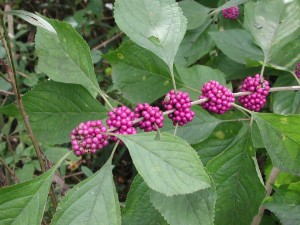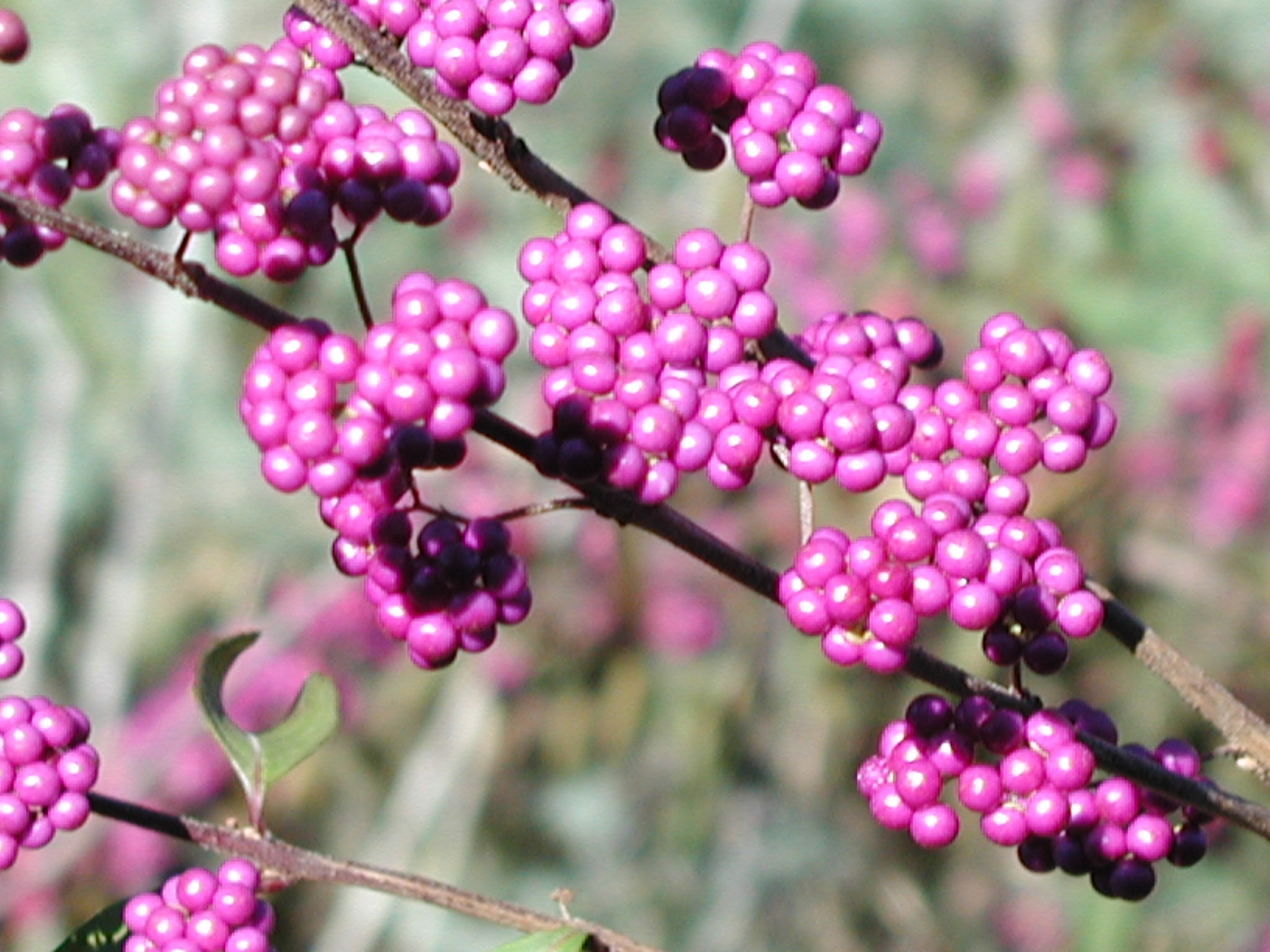 |
|
http://commons.wikimedia.org/wiki/User:Berean_Hunter |
 |
|
Translate this page:
Summary
Bloom Color: Lavender.
Main Bloom Time: Early spring, Late spring, Mid spring. Form: Rounded, Spreading or horizontal, Vase.
Physical Characteristics

 Callicarpa americana is a deciduous Shrub growing to 1.8 m (6ft) at a slow rate.
Callicarpa americana is a deciduous Shrub growing to 1.8 m (6ft) at a slow rate.
See above for USDA hardiness. It is hardy to UK zone 6. It is in flower from June to July. The species is hermaphrodite (has both male and female organs).
Suitable for: medium (loamy) soils and prefers well-drained soil. Suitable pH: mildly acid, neutral and basic (mildly alkaline) soils. It can grow in semi-shade (light woodland) or no shade. It prefers moist soil.
UK Hardiness Map
US Hardiness Map
Synonyms
Plant Habitats
Woodland Garden Dappled Shade;
Edible Uses
Edible Parts: Fruit
Edible Uses:
Fruit - raw[105, 177]. Juicy, sweet, fleshy, slightly aromatic[123]. The fruit is about 6mm in diameter[200].
References More on Edible Uses
Medicinal Uses
Plants For A Future can not take any responsibility for any adverse effects from the use of plants. Always seek advice from a professional before using a plant medicinally.
Diuretic Dysentery Malaria
A decoction of the root bark has been used as a diuretic[257]. The leaves are a cure for dropsy[61]. A tea made from the roots is used in the treatment of dysentery and stomach aches[222, 257]. A tea made from the roots and berries is used in the treatment of colic[222, 257]. Some native North American Indian tribes used the leaves and roots in sweat baths for the treatment of malaria, rheumatism and fevers[222, 257].
References More on Medicinal Uses
The Bookshop: Edible Plant Books
Our Latest books on Perennial Plants For Food Forests and Permaculture Gardens in paperback or digital formats.

Edible Tropical Plants
Food Forest Plants for Hotter Conditions: 250+ Plants For Tropical Food Forests & Permaculture Gardens.
More

Edible Temperate Plants
Plants for Your Food Forest: 500 Plants for Temperate Food Forests & Permaculture Gardens.
More

More Books
PFAF have eight books available in paperback and digital formats. Browse the shop for more information.
Shop Now
Other Uses
References More on Other Uses
Cultivation details
Landscape Uses:Border, Cascades, Erosion control, Foundation, Pest tolerant, Massing, Standard. Requires a sunny position or light dappled shade[1, 200]. Prefers a highly fertile well-drained loamy soil[200]. This species is hardy to about -18°c according to one report[200] whilst another says that it is only really hardy in the milder parts of Britain, though some forms should prove to be hardier[1]. Requires cross-pollination for good fruit production[182]. Plants in this genus are notably resistant to honey fungus[200]. Special Features:
Attracts birds, North American native, Fragrant foliage, Naturalizing, Attracts butterflies, Inconspicuous flowers or blooms.
References Carbon Farming Information and Carbon Sequestration Information
Temperature Converter
Type a value in the Celsius field to convert the value to Fahrenheit:
Fahrenheit:
The PFAF Bookshop
Plants For A Future have a number of books available in paperback and digital form. Book titles include Edible Plants, Edible Perennials, Edible Trees,Edible Shrubs, Woodland Gardening, and Temperate Food Forest Plants. Our new book is Food Forest Plants For Hotter Conditions (Tropical and Sub-Tropical).
Shop Now
Plant Propagation
Seed - sow February in a greenhouse[78]. Only just cover the seed[138]. Germination usually takes place within 1 - 3 months at 18°c[138]. When large enough to handle, prick the seedlings out into individual pots and grow them on in the greenhouse for at least their first winter, planting them out into their permanent positions in late spring or early summer, after the last expected frosts. Cuttings of half-ripe wood 10cm long, July/August in a frame. High percentage[78]. Cuttings of mature wood of the current season's growth with a heel[78] taken in early spring[200].
Other Names
If available other names are mentioned here
Native Plant Search
Search over 900 plants ideal for food forests and permaculture gardens. Filter to search native plants to your area. The plants selected are the plants in our book 'Plants For Your Food Forest: 500 Plants for Temperate Food Forests and Permaculture Gardens, as well as plants chosen for our forthcoming related books for Tropical/Hot Wet Climates and Mediterranean/Hot Dry Climates. Native Plant Search
Found In
Countries where the plant has been found are listed here if the information is available
Weed Potential
Right plant wrong place. We are currently updating this section.
Please note that a plant may be invasive in one area but may not in your area so it’s worth checking.
Conservation Status
IUCN Red List of Threatened Plants Status :

Growth: S = slow M = medium F = fast. Soil: L = light (sandy) M = medium H = heavy (clay). pH: A = acid N = neutral B = basic (alkaline). Shade: F = full shade S = semi-shade N = no shade. Moisture: D = dry M = Moist We = wet Wa = water.

Expert comment
Author
L.
Botanical References
1143200
Links / References
For a list of references used on this page please go here
Readers comment